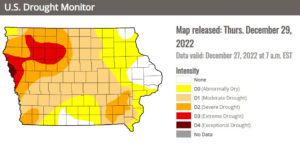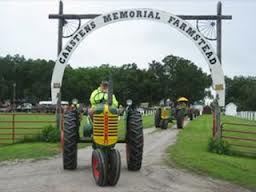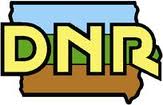CLICK HERE for the latest market quotes from the Iowa Agribusiness Network!
CLICK HERE for the latest market quotes from the Brownfield Ag News Network!
CLICK HERE for the latest market quotes from the Iowa Agribusiness Network!
CLICK HERE for the latest market quotes from the Brownfield Ag News Network!
(Radio Iowa) – Despite several rounds of heavy snow in recent weeks, it will take significantly more precipitation to break Iowa’s long-running drought. State climatologist Justin Glisan says much of the state is far behind on moisture levels. “We’re going to need several months, if not more than a year, of above-average precipitation in those drier parts of the central region and western Iowa,” Glisan says. “You look at Sioux City, around there, 47% of normal precipitation for the year, going back three years, 25 inches below-average-plus in certain parts of the state.”
Large portions of Iowa are in moderate to severe drought, and multiple northwest Iowa counties are in the D-3 category of extreme drought, but parts of Woodbury and Monona counties are in the worst category, D-4, for exceptional drought. Glisan says the soil needs to recharge in order to rebound.
“You really have to get a lot of water into the soil profile to replenish those stocks, but also wetter soils will get more runoff into the stream, so you’ll see a rebound in those stream flows as well,” Glisan says. “So we’re going to need, in those D-3 and D-4 regions, a lot of precipitation to put a dent in those longer-term deficits.” Glisan says it takes a lot of snow to melt down to usable precipitation. He says it’s anywhere from eight to 12 inches of snow that equate to one inch of rainfall. 
“So you’re not getting a lot of water out of that snowpack, number one,” Glisan says, “but if the drier soils are frozen deeper, it’s going to take a while for those profiles to thaw late winter/early spring, so even if you’re melting that snowpack, a lot of that’s not infiltrating, it’s running off.”
Much of Iowa, Nebraska and South Dakota has been in a significant drought for most of the last two years.
(Radio Iowa) – The growing of industrial hemp has not taken off as some envisioned when it returned to Iowa fields in 2020. Lane Kozel with the Iowa Department of Agriculture says the number of growers fell again this season. “Believe last year, we dropped to 45. And this year, we had 33, licensed growers. Of those 33, 26 growers actually planted a hemp crop. So we’re down to about 26 growers this year,” he says. “So it’s been cut in half every year since the program was started.” Kozel says one of the factors is the cost of the inputs and the amount of manual labor needed to properly cultivate and grow a crop .
“I don’t think there’s a market for it as well, I don’t think that’s been established is to help out or growers either,” Kozel says. The processing needed to extract the C-D-B or to create seeds, for grain or fiber has not taken off in Iowa. “Once it grows and there’s no place to go with it — that’s kind of leads to people not being interested either,” he says. Many other states also approved industrial hemp programs, and he says that created a lot of product. “You know, there’s been talked as long as it’s programs and going people have been, sitting on previous crops. C-B-D, that seemed to be the big boom, in previous years. And I think the market is saturated with that,” Kozel says. “And so until we can find some uses for some fiber and some grain, I think it’s going to stay where its at.” Kozel says there needs to be development of processing to use the hemp to make it worthwhile for growers to invest in.
“When we first started the program, I mean, everyone’s got, you know, great ideas with hemp concrete and housing, building material and clothing and what have you, but there’s just none of that going on right now, to my knowledge,” according to Kozel. “I’m sure there’s some small businesses in the country that are making him closing blue jeans out of hemp and things like that. But far as an Iowa, there’s nothing.”
The industrial hemp is required to pass a test that shows it has a T-H-C level below three-point-nine percent. The crop has to be destroyed if it can’t meet that standard. Kozel says everyone passed the test this year.
(Radio Iowa) – The top Republican in the Iowa House says the 2023 legislature is unlikely to fill a state fund created to finance water quality and outdoor recreation projects. In 2010, Iowa voters passed a constitutional amendment creating the Natural Resources and Outdoor Recreation Trust Fund where money from a FUTURE sales tax increase would be deposited. Last year, Senate Republicans proposed a maneuver to fill that fund, by converting all local option sales taxes to a statewide one percent sales tax.
House Speaker Pat Grassley says about 50 cities and counties, though, do not have a local option sales tax, so it would be an increase in those areas. “Now I know there are people that want to offset it and different conversations,” Grassley says, “but at the end of the day, it could cost somebody something.” In early 2020, Governor Kim Reynolds proposed a one cent sales tax increase as part of a plan that put money in the Natural Resources and Outdoor Recreation Fund AND reduce state taxes overall, however the proposal drew some G-O-P opposition and was tabled once the pandemic hit.
The 2023 legislative session begins Monday.
(Radio Iowa) – The Iowa Department of Natural Resources will stock rainbow trout in five urban lakes and ponds this month for anglers who enjoy winter fishing. Mike Steuck, the D-N-R’s regional fisheries supervisor for northeast Iowa, says trout get stressed in warmer water and can even die if the temperature is too high. “They don’t like temperatures higher than 70,” Steuck says. “So they’ll quit feeding. They act a little funny and they try and seek out colder water sources.”
Steuck says water temperatures are much cooler now, in the 30s, so it’s an ideal time for the D-N-R to stock the trout — and for Iowans to seek them out by casting a line. “We want people to catch them right away,” he says, “and take them home and see how good fish are to eat and see how much fun fishing is.”
Steuck says the DNR will stock one-to-two-thousand trout in lakes in Sioux City, Council Bluffs, Mason City and a few other locations. He says people catch the fish generally within a month after they’re stocked.
(reporting by Katie Peikes, Iowa Public Radio)
(Guthrie Center, Iowa; Article submitted) – The Guthrie County SESS Range Finders 4-H club held their annual awards night on Sunday, December 4 at the Guthrie Fairgrounds Events Center. Huge thank you to the Guthrie Fair Board for allowing us to use their facility! All club member families were invited to attend this event and we had 11 members present. The evening started off with a potluck dinner with some amazing food. Next, we inducted our new 2022-2023 club officers of: President Emma Rutledge, Vice President Michelle Brooks, Secretary Kaylee Oberholtz, Treasurer Max Owen, Reporter Corrie Knapp, Photographer Piper Downing, Historian Gracie Hodges. It was then time to have our new officers run the monthly meeting. We welcomed our new club members of Dalton Carney, Payson Downing, and Ian Griffith. We ended the night with our club award presentation from the 2021-2022 4-H year.
Emma Rutledge, President, started off with recognizing and thanking SESS volunteers with year of service pins.

Left to right in front row: Max Owen, Alala Derry, Payton Downing, Ian Griffith, Corrie Knapp
From left to right in back row: Trever Derry, Aries Derry, Emma Rutledge, Kaylee Oberholtz, Michelle Brooks, Piper Downing (Photo submitted)
The instructors then took turns reading and handing out club awards. SESS awards recognize the following: Officers, Committee Participation, Club Presentations, Club Tour Participation, County Fair Participation, Community Service Event Participation, Discipline Safety Awards, Postal Shoot Participation, State Shoot Participation, Nationals Participation of Eli Madsen and Max Owen, Graduation, Perfect Attendance of Trever Derry and Max Owen, and most importantly our Member Excellence Award. Although all SESS awards are an honor, the Member Excellence is our highest award and the following members received it: Trever Derry, Corrie Knapp, Jalen Michaelson, Kaylee Oberholtz, Max Owen, and Emma Rutledge.
(Submitted by Corrie Knapp, Reporter)
(Shelby, Iowa) – The Carstens 1880 Farmstead, Inc. will hold its annual meeting on Tuesday, January 10, 2023 at the Shelby Community Hall in Shelby at 7:30 pm. Board President Charlie Leaders, of Minden, says “We encourage everyone to come out and hear about what’s happening at the farm.” Members of Carstens Farm will be voting for four positions on the board of directors. The following board members’ terms are ending as of the date of the meeting: Charlie Leaders and Ben Ausdemore of Minden, Stanley Kern of Shelby and Rick Newland of Portsmouth. All four are running for another term.
Continuing board members are Gerald McCool and David Dittmer of Minden, Dale Schroder of Avoca, Bill Johnson and Doug Martin of Shelby, Harvey Ferris of Missouri Valley and Terry Torneten of Harlan. Results of the election will be announced following the meeting.
Leaders said “We are listing ideas for projects in 2023. We want to continue our focus on building upkeep and repair.” Reports will be given on the 2022 Carstens Farm Days show. Leaders said also, “I hope to see many members as well as the general public at the meeting because we want to continue to grow our membership.” 
Carstens 1880 Farmstead, Inc. members as well as members of the public are welcome and encouraged to attend. Those attending will have the opportunity to renew their memberships or to purchase new memberships. Memberships are important for sustaining the farm’s operations. New or renewing members should note that membership rates remain the same as last year: $25 for family; $15 for an individual. Visit the farm’s website for membership information.
Carstens 1880 Farmstead, Inc., a non-profit group of local volunteers, oversees this working farmstead museum exhibit located south of Shelby, Iowa. The farmstead hosts several thousand people annually during Carstens Farm Days which is held the first weekend after Labor Day. For more information visit www.carstensfarm.com
MISSOURI VALLEY – The Iowa Department of Natural Resources (DNR) will treat Nobles Lake with a low concentration of rotenone to eliminate rough fish. Nobles Lake, 95-acre cutoff oxbow lake located in Harrison and Pottawatomie counties on the Missouri River floodplain, was inundated and infested with numerous invasive and river fish species during the floods of 2011 and 2019.
The dryer than normal conditions and historic low flows in the Missouri River has nearly drained Nobles Lake, providing ideal conditions to remove rough fish. Invasive species like silver carp, bighead carp, shortnose gar and common carp have a negative impact on water quality and wildlife habitat by suppressing aquatic plants. “The most effective method to eliminate the remaining fish population is to apply rotenone under the ice this winter,” said Bryan Hayes, fisheries management biologist with the Iowa DNR. 
Rotenone is used world-wide and has been since the 1930s. It is a common tool that fisheries managers use for fish removal. Rotenone is a naturally occurring compound that comes from the roots of a tropical plant in the bean family. The Iowa DNR commonly uses the commercially available formulation, five percent Prenfish, which has been approved for fisheries management by the U.S. Environmental Protection Agency (EPA).
Nobles Lake is part of a larger 236-acre Iowa DNR Wildlife Management Area primarily used by waterfowl hunters and bird watchers.
Ag/Outdoor, Heartbeat Today, Podcasts
Jim Field visit with Kendra Meyer, Executive Secretary of the Iowa Specialty Crop Growers Association, about the Iowa Specialty Producers Conference February 22-23 in Ankeny. Visit www.iowaspecialtyproducers.com/registernow.
Podcast: Play in new window | Download (21.9MB)
Subscribe: RSS